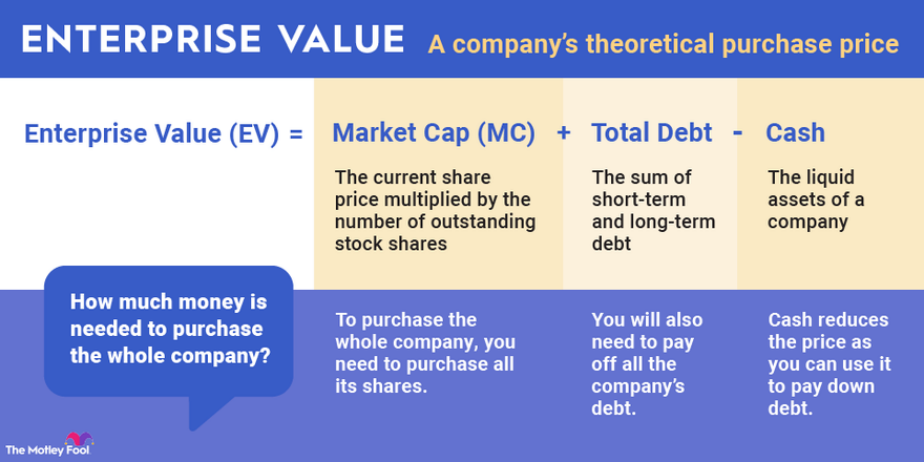Market Capitalization and Enterprise Value
주요 학습 목표:
Introduction: Venture into the world of Market Capitalization and Enterprise Value to enhance your
ability in evaluating and comparing companies within the same industry, gauging their relative size and
value.
1. Market Capitalization Mastery: 이해하다 market capitalization as a metric representing
the total value of a company’s outstanding shares of stock.
2. Enterprise Value Understanding: 로 뛰어 들어라 enterprise value, a more comprehensive
measure considering market cap, the company’s debt, and its cash holdings.
3. Comparative Analysis Skills: Develop skills in using both market capitalization 그리고
enterprise value for comparing companies within the same industry and gauging their
relative size and value.
소개
Market capitalization and enterprise value are two essential metrics used to assess the size and value of a company. Both can be used for investment analysis and to compare companies within an industry. In this chapter, we will explore the meaning, differences, and applications of market capitalization and enterprise value in investment analysis.
23.1 Market Capitalization
Market capitalization (market cap) is the total value of a company’s outstanding shares of stock. It is calculated by multiplying the company’s stock price by the number of shares outstanding.
Market Cap = Stock Price x Shares Outstanding
예:
Company B has 1,000,000 shares outstanding
The current market price of Company B’s stock is $50.00
Market Cap = $50.00 x 1,000,000 = $50,000,000
23.2 Enterprise Value

Figure title: Calculating Enterprise Value
원천: 가지각색의 바보
설명: This figure demystifies the formula for calculating Enterprise Value, an essential metric that provides a more complete valuation of a company than market capitalization alone.
주요 시사점:
- Enterprise Value Formula: Market Cap + Total Debt – Cash gives you a full picture of a company’s total value.
- Beyond Market Cap: While market capitalization only considers equity (stock), Enterprise Value also incorporates debt and subtracts cash and equivalents.
- Investor’s Perspective: This measure can be particularly useful when comparing companies with different capital structures or debt levels.
애플리케이션: Enterprise Value is a critical metric for investors who are interested in the total value of a business, allowing for more accurate company comparisons and investment choices.
23.3 Differences between Market Capitalization and Enterprise Value
Market capitalization only considers the value of a company’s equity, whereas enterprise value takes into account the company’s debt and cash holdings. As a result, enterprise value provides a more comprehensive picture of a company’s overall value.
23.4 Using Market Capitalization and Enterprise Value in Investment Analysis
Market capitalization and enterprise value can be used to compare companies within the same industry and determine their relative size and value. Investors can use these metrics to identify potential investment opportunities by looking for companies that appear undervalued compared to their peers.
예:
Company C has a market cap of $75,000,000 and an enterprise value of $80,000,000.
Company D has a market cap of $100,000,000 and an enterprise value of $110,000,000.
By comparing these metrics, an investor may conclude that Company C is relatively undervalued compared to Company D.
In summary, understanding key financial data points, market capitalization, and enterprise value is crucial for investors who want to make informed decisions and identify potential investment opportunities. By analyzing these metrics, investors can gain insights into a company’s financial health, performance, and growth potential.
주요 시사점:
Closing Statement: The knowledge of Market Capitalization and Enterprise Value is pivotal in
dissecting a company’s financial stature in comparison to its peers. As you gain proficiency in these
metrics, you unravel a more precise layer of company valuation and comparative analysis, sharpening
your investment acumen.
1. Market Capitalization provides a quick glance at a company’s equity value based on its
current stock price and the number of shares outstanding.
2. Enterprise Value offers a more holistic view of a company’s worth, including its debt and
cash positions.
3. Investors can use both these metrics to find undervalued companies in the market, enhancing
their investment decision-making process.
4. Recognizing the difference between market capitalization and enterprise value is vital for
accurate company valuation and comparison.

